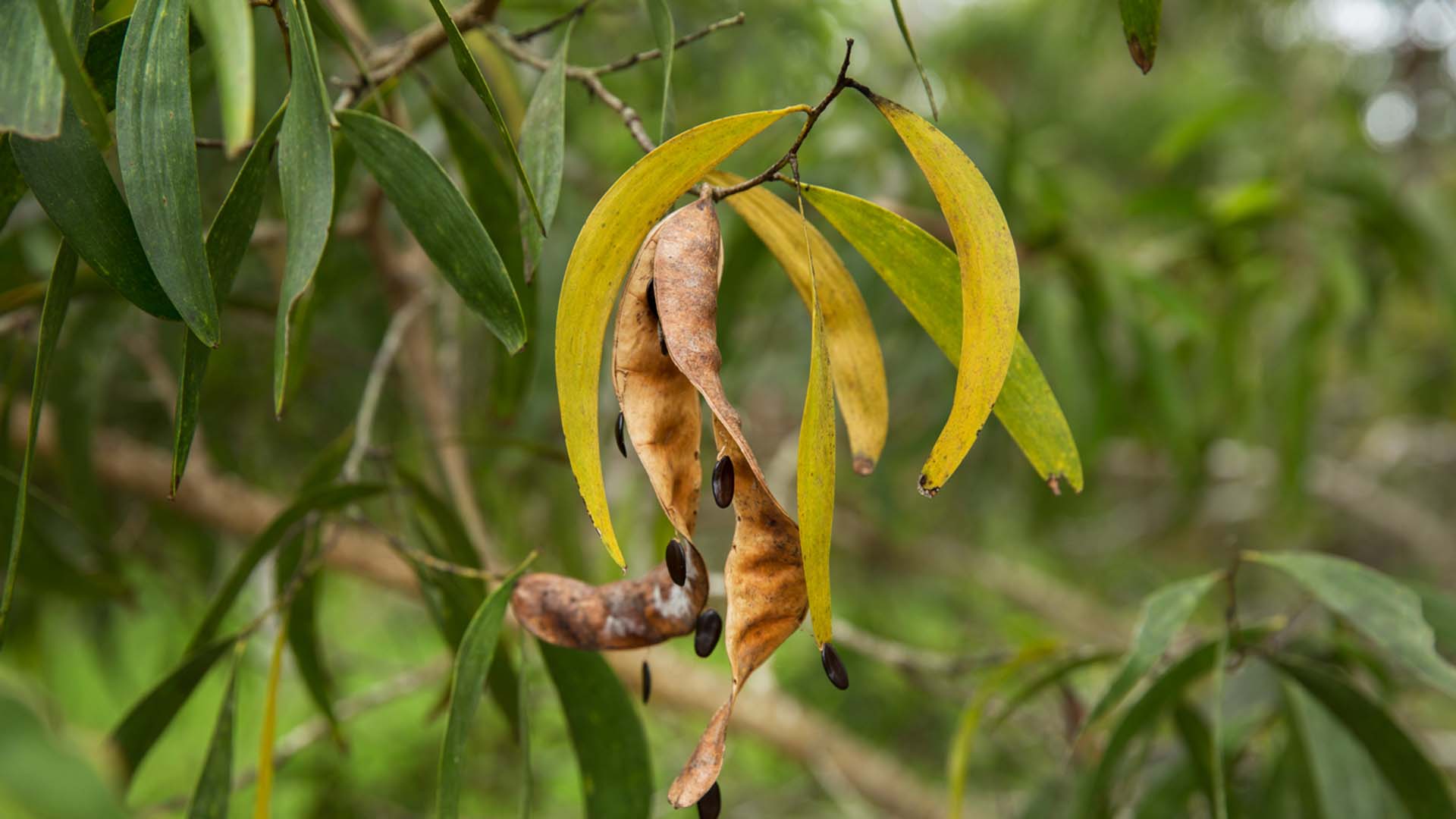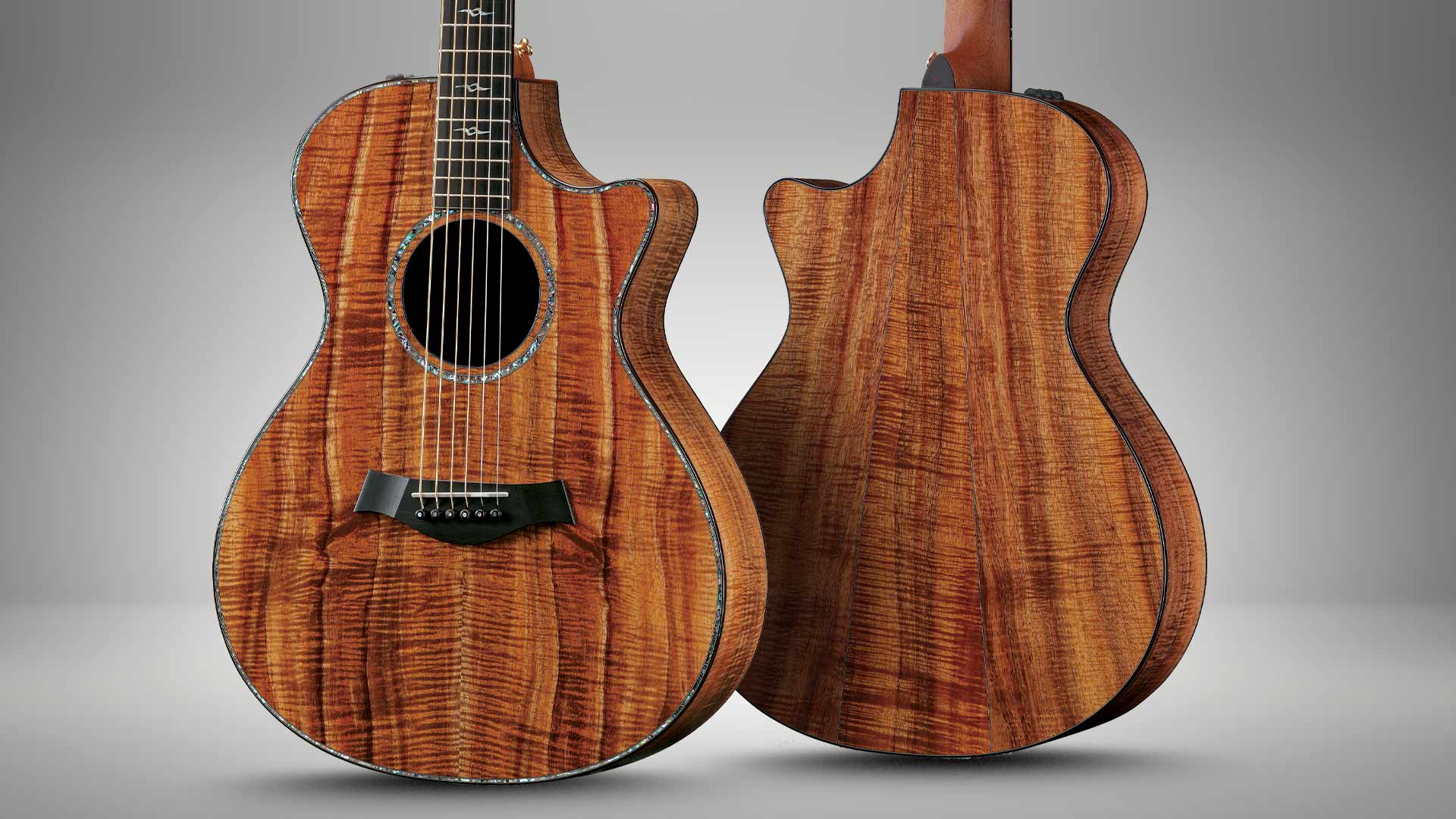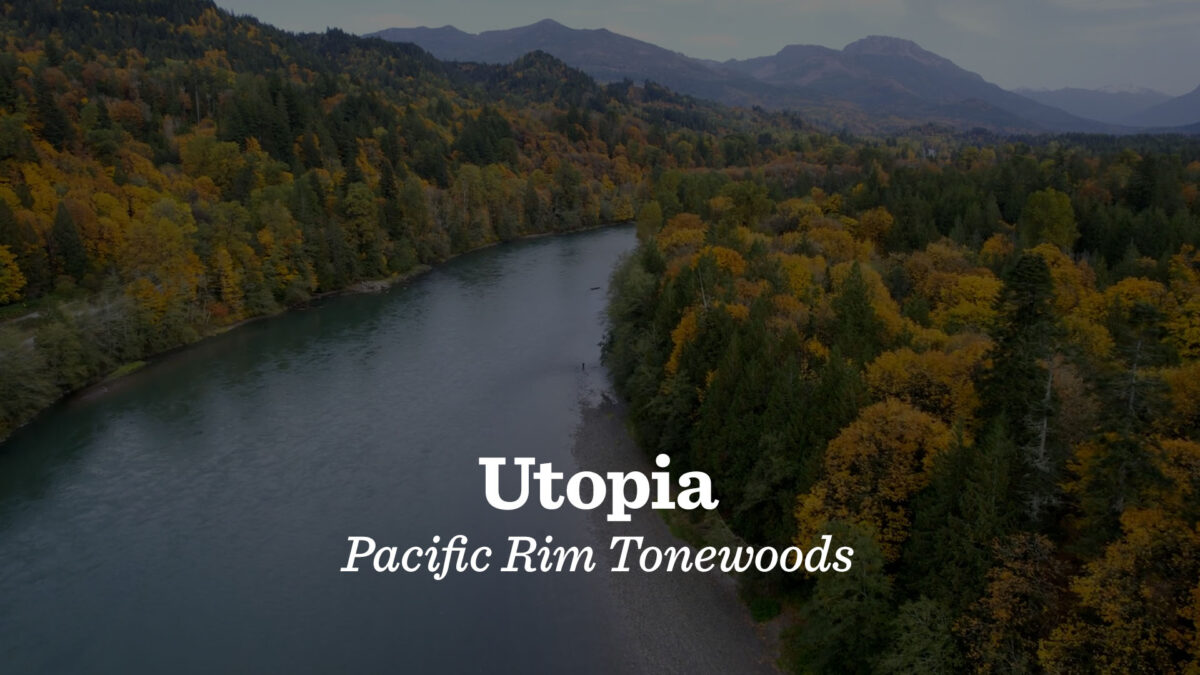In previous issues of Wood&Steel, Taylor Director of Natural Resource Sustainability Scott Paul has shared updates on the koa forest restoration projects we’ve embarked on in Hawaii with our longtime supply partner, Pacific Rim Tonewoods. In conjunction with the launch of our koa 700 Series, we wanted to offer a fresh look at the various facets of our forest stewardship work in Hawaii, including seed selection, genetic research and plant cultivation as we grow trees for the future.
If you’re a fan of koa, you might know that it grows exclusively on the Hawaiian Islands. But chances are you’re less familiar with koa’s ecological status. Due in part to its remote island home, people often wonder whether koa is endangered. (It’s not.) But over time, koa’s Hawaiian habitat has changed, leading to a gradual decline in the health of native forests in certain areas, with koa regeneration diminished by a variety of factors.
Prior to Polynesian settlement on the Hawaiian Islands around 1200 A.D., koa grew across a wide range of habitats and elevations, nearly down to sea level. It’s the largest tree native to Hawaii, and it grows rapidly (about five feet per year for the first five years in healthy conditions). As a resource, koa wood was widely used by Hawaiians for many purposes, but especially for canoes. By 1778, when British Naval explorer Captain James Cook’s landfall precipitated a sustained wave of Western contact — and greater interest in koa as a material to make products like cabinetry and furniture — native koa forests still extended down to a 2,000-foot elevation.
After the introduction of cattle to Hawaii in 1793 by another British explorer, Captain George Vancouver — who presented King Kamehameha with a gift of six cows and a bull — Hawaii’s island ecosystem underwent a gradual transformation. Forestland was cleared for ranches, while at the same time, a growing population of wild cattle snacked on newly sprouted koa seedlings, stifling natural koa regeneration.
Additionally, in the early-to mid-1800s, agricultural conversion for large-scale sugar and pineapple production consumed some of the low-elevation koa forests. Over time, as Hawaii’s population grew, private land development, coupled with the introduction of non-native plant, animal, insect and micro-organic life, including invasive species, further reduced the natural propagation of koa.
Today, there is still a good deal of koa forest in Hawaii, but most of it sits above 4,000 feet, on private or protected lands. And much of what survives is in decline, with regeneration severely impeded by many threats, including roaming feral cattle, sheep and pigs; invasive plant species like gorse, kahili ginger and strawberry guava; various grass species that were introduced for cattle grazing but have also fueled the spread of wildfires into forest areas; and a soil-borne fungus, commonly known as fusarium wilt, that has killed numerous koa trees at lower elevations.
For these reasons, native forest restoration to reverse this decline has been a concerted effort on the Islands, with considerable research and initiatives currently underway. This includes efforts both to enhance the ecology of existing forests and to restore some previously converted pastureland back to its native forest state.
Koa and Guitars
Taylor’s history of making guitars with koa stretches back more than 40 years. Pacific Rim Tonewoods has been in the koa supply business for about 30 years and has cut the koa Taylor has purchased for much of that time.
Koa lumber was widely available until about 20 years ago, when Hawaii stopped clearing land for agriculture, which reduced the amount of koa coming to the mainland. After that, it was available chiefly — and unpredictably — from salvage. About seven years ago, in 2015, koa became extremely difficult to source for guitars, so Bob Taylor and Steve McMinn from Pacific Rim Tonewoods began to investigate further to better understand the sourcing outlook for the future. They learned more about the protections against harvesting koa on public and private land in Hawaii and met with large landowners to discuss their current land stewardship needs and future conservation goals.
In this video, Steve McMinn and other partners talk about the mission of Siglo Tonewoods and our koa forest restoration efforts in Hawaii.
Those efforts led to the launch of a formal partnership between Taylor Guitars and Pacific Rim Tonewoods. Until recently, the joint venture was called Paniolo Tonewoods — “Paniolo” being a reference to the Mexican cowboys who originally came to Hawaii to teach Hawaiians ranching skills (and brought their guitars and music with them) — but the name was recently changed to Siglo Tonewoods. (“Siglo” means “century” in Spanish, alluding to the long-term vision of the company.)
The mission of Siglo is to supply and grow Hawaiian wood for the future (100 years and beyond) and create an enduring supply of wood for musical instruments. Part of that commitment is to contribute to current forest restoration efforts on a project basis through contracts with Hawaiian landowners. This also includes the development of various tree improvement programs to improve wilt resistance and to cultivate seed orchards.

Stewardship Contracting
As Scott Paul explained in a previous Wood&Steel column (“Three-Part Harmony,” 2020/Vol. 97/Issue 2), Siglo (then Paniolo) adopted an innovative stewardship contracting approach first implemented by the U.S. Forest Service and The Nature Conservancy, which addressed the significant costs associated with forest restoration. Instead of paying a landowner for logs or harvesting rights, Siglo would be allowed to cut a select number of koa trees from a compromised forest area and in exchange would invest the dollar-for-dollar value of that wood into forest improvement projects on that land.
Demonstration Cases
One of the earliest projects, which helped Siglo demonstrate its unique capabilities and ethical intentions in Hawaii, was a collaboration with Haleakala Ranch on Maui in 2015. Two stands of koa had been planted in 1985 in conjunction with a program called “A Million Trees of Aloha,” started by Jean Ariyoshi, the wife of Hawaii’s then-governor, George Ariyoshi. Unfortunately, the 30-year-old trees were in decline for various reasons, which had stunted their growth. They had begun showing signs of heart rot, which would only get worse. Typically, such “young” koa (not from natural forests), especially these compromised trees, would be shunned by buyers. But Siglo, and later Taylor, agreed to work with this wood. Taylor had to take additional measures to be able to make guitars with the wood, but in the end it was used on tens of thousands of guitars, proving that young koa could in fact make instrument-grade wood. The proceeds from the sale of the wood in turn allowed Haleakala Ranch to increase the rate of its ongoing forest restoration efforts on neighboring land.
Another early project, which launched in 2017, was a five-year stewardship conservation contract on 1,600 acres owned by Kamehameha Schools, the largest landowner in Hawaii, in the Honaunau Forest, located on Hawaii Island. Though a mandate had been established to restore the health of the forest, there had been no tree harvesting there since the 1990s, which meant no income stream to fund the efforts needed. The contract enabled Siglo to harvest a select number of koa trees, and according to Siglo general manager Nick Koch, the proceeds from the sale of the wood — about $1.6 million — have gone into a conservation fund, about $1 million of which has been spent so far, largely for fencing and animal control. As a result of these efforts, there are tens of thousands of new koa trees in that area.
Koa is one of the few woods in the world for which the supply forecast for the next 25 years is brighter than it is today.
These types of project-based stewardship contracts will provide Siglo with a more predictable supply of koa in the short term, while other efforts are simultaneously underway to rehabilitate forests and plant trees for a more sustainable long-term supply into the next century. It all adds up to a favorable outlook for the future: Koa is one of the few woods in the world for which the supply forecast for the next 25 years is brighter than it is today.
Planting Trees and Building a Mill
Siglo took an important step toward its planting goals in 2018, when Bob Taylor purchased 564 acres of pastureland on the Big Island, near Waimea. The land had been a legendary koa forest some 150 years earlier. Officially named Siglo Forest, the land is being leased by Siglo Tonewoods, and a plan was developed to plant mixed native species in the steep-sloped areas, which will be set aside for conservation (30 percent of the property) and to plant koa in the less steeply sloped areas for timber production. When Siglo Forest is mature, it will provide more than twice the volume of wood that Taylor currently uses, and the management plan will ensure a perpetual, diverse native working forest supply.
As we reported in the fall of 2021, planting efforts began that June with koa seedlings and mixed native tree and shrub species on 20 acres. A lot was learned, which helped to improve the viability of future plantings. The goal is to plant 150,000 koa trees there by 2030, with the first useful harvest likely in 2050.
When Siglo Forest is mature, the management plan will ensure a perpetual, diverse native working forest supply.
There are also plans in the works to build a mill, which will enable Siglo Tonewoods to cut koa efficiently in Hawaii and enable vertical integration. Once operational, the mill will be used to cut both koa and additional instrument woods, while also producing other value-added wood products such as flooring for the Islands. The mill will enable better quality control and generate jobs to support the local economy. In the meantime, Siglo has improved its operational capabilities in Hawaii by investing its own logging equipment, which allows better, more careful utilization of the trees it extracts.
Seed Selection and Improving Koa Genetics
One critical component of developing a successful koa planting program — one that yields healthy and desirable koa trees — is conducting appropriate ecological research for optimal results. Both Bob Taylor and Steve McMinn understand the importance of such studies from their work with other tonewoods. For Bob, the scalable ebony planting initiative in Cameroon, better known as the Ebony Project, was predicated on groundbreaking research Bob funded to better understand optimal ebony propagation strategies. In Steve’s case, some Wood&Steel readers may recall our story (Winter 2015, Vol. 81) about the research Steve pursued into growing Big Leaf maple with desirable genetics for musical instruments, i.e., with attractive figure. That project has continued to progress, with forestry trials currently underway on a plot of former farmland near their company’s mill in Washington state’s Skagit Valley, called Utopia Forest, where they are researching whether figure in trees is genetically transmissible. There are interesting parallels between maple and koa, both of which grow to a useful size rapidly — namely the desire to grow trees with figure for musical instruments and other premium products. Steve and his team recently made a video that explains the project.
Kevin Burke, a horticulturist from Pacific Rim Tonewoods who has overseen the maple trials, has also been coordinating a similar project with koa in Hawaii. The goal is to propagate genetically superior trees to restore the genetic range and quality of koa, which has been diminished over the previous centuries.
The project launched in 2016, shortly after Siglo Tonewoods was established, as a research partnership with Haleakala Ranch and is being conducted at Native Nursery on Maui. It began with the cooperative cultivation of lines of trees from Haleakala Ranch that had been selected for the extraordinary quality of the wood. Currently, 65 clonal lines from the trees are under propagation, and 10 lines have been micro-propagated.
In a similar vein, Siglo has sponsored research with the Hawaiian Agricultural Research Center (HARC) and the U.S. Forest Service Tropical Tree improvement Program. This led to the launch of a seed selection program in 2021, which aims to help reforest Hawaii with the genetics of superior koa trees. Seeds were captured from 42 “plus” trees, which are now growing on as seedlings and being tested for wilt resistance, which will optimize their chances of staying healthy. The research has also identified many more “plus” trees whose seed they will eventually be able to collect.
Compared to maple, Burke says, koa is easier to grow from seed. Figure in young koa is also much more prevalent, and evident earlier.

Siglo also worked in partnership with HARC to plant a 1,600-tree seed orchard/progeny trial at Siglo Forest, using wilt-resistant seed. This should yield operational seed in 2026. HARC is also currently in the midst of a wilt-resistance testing program with cultivars developed at Haleakala Ranch along with seed collected from Siglo’s 2021 seed selection/tree improvement program.
So far in 2022, 12,500 windbreak trees have been planted at Siglo Forest, the seed orchard has been expanded, and another 30 acres of koa and mixed forest were planted. Meanwhile, Siglo Tonewoods has also leased a greenhouse in Waimea to support its ongoing propagation efforts. Ultimately, Steve McMinn says, the research and other strategic thinking the team has poured into developing and refining their planting initiative is intended to provide a scalable blueprint for others who are interested in koa reforestation and afforestation (planting trees on land that was not recently covered in forest, such as pastureland) across Hawaii. Look for more stories on the progress of these projects in future editions of Wood&Steel.







